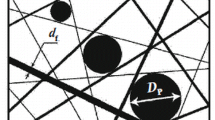Abstract
The structure of the composite viscose—polyester fibre examined allows processing textile articles with high physicomechanical indexes combined with good hygienic and comfort properties. Polynomial models that satisfactorily reflect the dependence of optimization criteria on the process parameters in production of composite viscose—polyester fibres are obtained. The analysis of the models allows establishing the optimum process parameters for processing composite viscose—polyester fibres for mass market consumer goods; K 1 = 480 tw./m, K 2 = 320 tw./m, P = 20 cN.
Similar content being viewed by others
REFERENCES
A. G. Sevost'yanov, Methods and Means of Investigation of Mechanical Industrial Processes in the Textile Industry [in Russian], Legkaya Industriya, Moscow (1980).
E. V. Illarionova and V. A. Rodionov, in: Proceedings of the Scientific Conference on the Effect of the Twist Value on the Physicomechanical Properties of Viscose—Polyester Composite Fibres [in Russian], MGTU, Moscow (2000).
Author information
Authors and Affiliations
Rights and permissions
About this article
Cite this article
Illarionova, E.V., Rodionov, V.A., Sychev, A.G. et al. Composite Viscose—Polyester Fibre Production Technology. Fibre Chemistry 34, 342–345 (2002). https://doi.org/10.1023/A:1022107001523
Issue Date:
DOI: https://doi.org/10.1023/A:1022107001523




